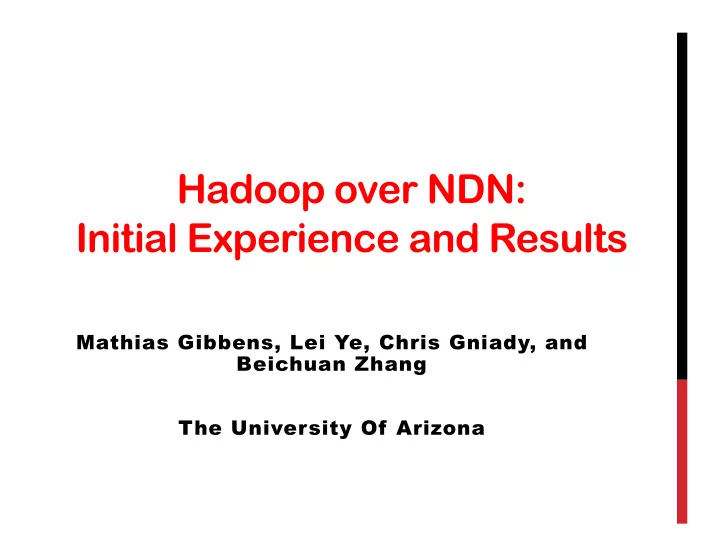

Hadoop over NDN: Initial Experience and Results Mathias Gibbens, Lei Ye, Chris Gniady, and Beichuan Zhang The University Of Arizona
Overview The research goal: apply NDN to the data center network environment to improve the storage, access, and processing of large amount of data. The current work: modify Hadoop to run on top of NDN to establish performance baseline, and collect research problems, still work in process. The next step: design NDN-native distributed filesystem and network mechanisms to improve system performance and resiliency. 1
What is Hadoop A popular MapReduce framework for distributed storage and processing of large data sets. 2 http://bradhedlund.com/2011/09/10/understanding-hadoop-clusters-and-the-network/
Hadoop Distributed File System By default, data is stored in the Hadoop Distributed File System (HDFS), in the unit of Blocks. HDFS replicates each Block to three different DataNodes along with checksums to ensure data integrity Cluster-wide consistent states provided by NameNode • Maintain states of entire HDFS • All requests of data placement and retrieval go through it. • Receiving heartbeats from DataNodes and initiate recovery after failures detected. 3
Why Hadoop over NDN Hadoop is a complex piece of software that requires non- trivial configuration and tuning for good performance. NDN can improve the performance • Caching, multicast, multi-path and multi-source data retrieval. Increase resiliency and failure handling • Get data from any working node that stores the data • Interest-data feedback loop to quickly detect failures and adapt to them by forwarding strategy Simplify implementation • Many network-related functions are handled by NDN. Signature for data integrity and security 4
Making Hadoop running on NDN A challenging task to modify a complex piece of software • As the first step, simply convert all the communication to “NDN Sockets” using address/port in the names. • Future work is to make the application logic NDN-native. 5
Making Hadoop running on NDN Remote Procedure Calls (RPC) • Used between NameNode and DataNodes • RPC requests and responses can be naturally mapped to NDN Interests and Data. • A name contains address, port, timestamp, and nonce to make it unique. TCP data transfer • Between DataNodes for bulk data transfer • Writing a Block in HDFS requires 2 other replicas. • Need to convert the “push” model to “pull”, which becomes multicast to the replicas. 6
Experiments Run a diverse set of benchmarks on two Hadoop clusters. 7
Writing 1GB data 8
Cache hit over 30-second bins 9
A missing piece: congestion control 10
Code changes 11
Conclusions Opportunities for traffic reduction • Caching and multicast. Other potentials • Multipath, multi-source data transfer • Resiliency: failure detection and recovery • Code simplification Challenges • Routing, forwarding strategy, etc. to realize the potentials. 12
Comments and Suggestions? 13
Recommend
More recommend